Abstract
A case-control study of bladder cancer was conducted in five United States rubber and tyre companies to determine if there were high-risk jobs and work areas within the industry. The study included 220 male cases of bladder cancer, of whom 107 were identified from hospital record reviews and 113 from death certificates. Each case was matched individually with two industry controls by sex, race, year of birth, and company. One control was matched additionally by year of hire and duration of employment. Comparisons of cases and controls not matched by year of hire and age of hire showed no differences for those variables, which suggests that age and calendar period of first exposure to the industry were not risk determinants. When the work histories of both cases and controls were contrasted it was found that cases were more likely than controls to have worked in milling (odds ratio (OR) = 1.91) and calender operation (OR = 2.21) jobs. The relative risk estimates for milling and calender operation both exhibited linear trends of increase with duration of exposure. Milling and calender operation jobs entail potential exposures to volatilised reaction products from heated rubber stock. A better understanding of aetiological associations with job type will require more detailed characterisation of the work environment with regard to the sources and levels of aromatic amines and other suspected bladder carcinogens.
Full text
PDF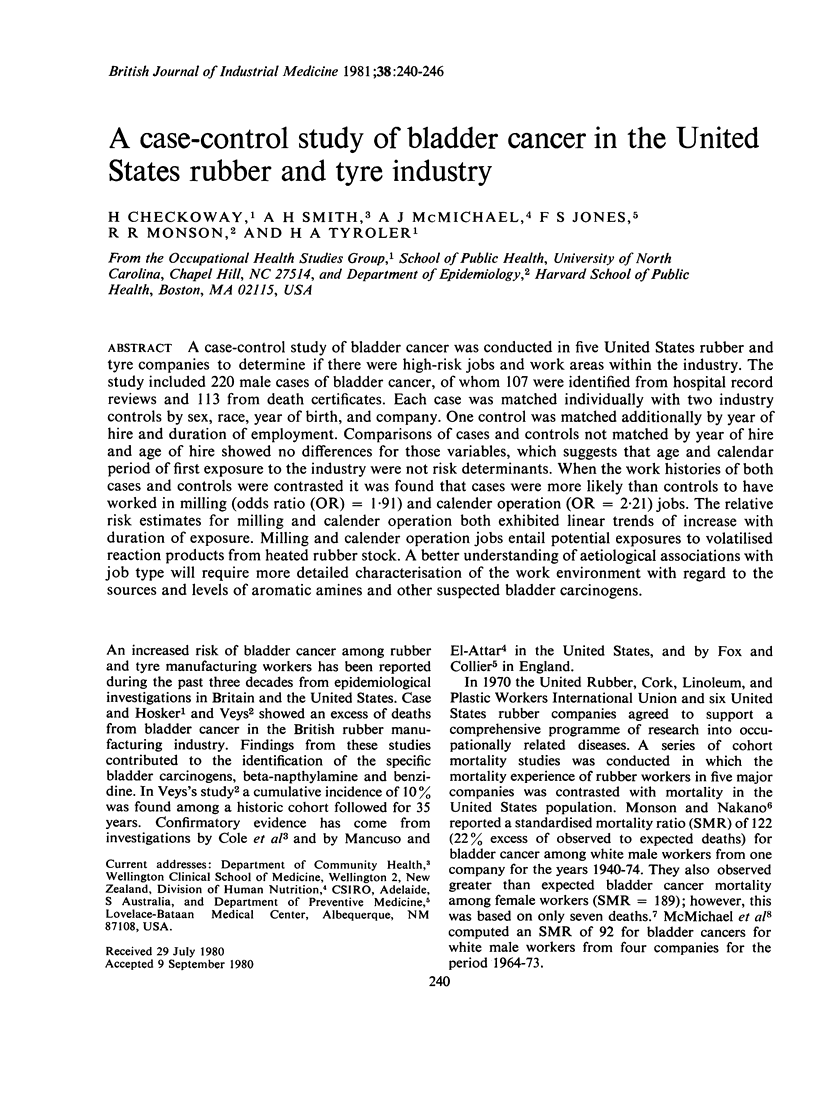
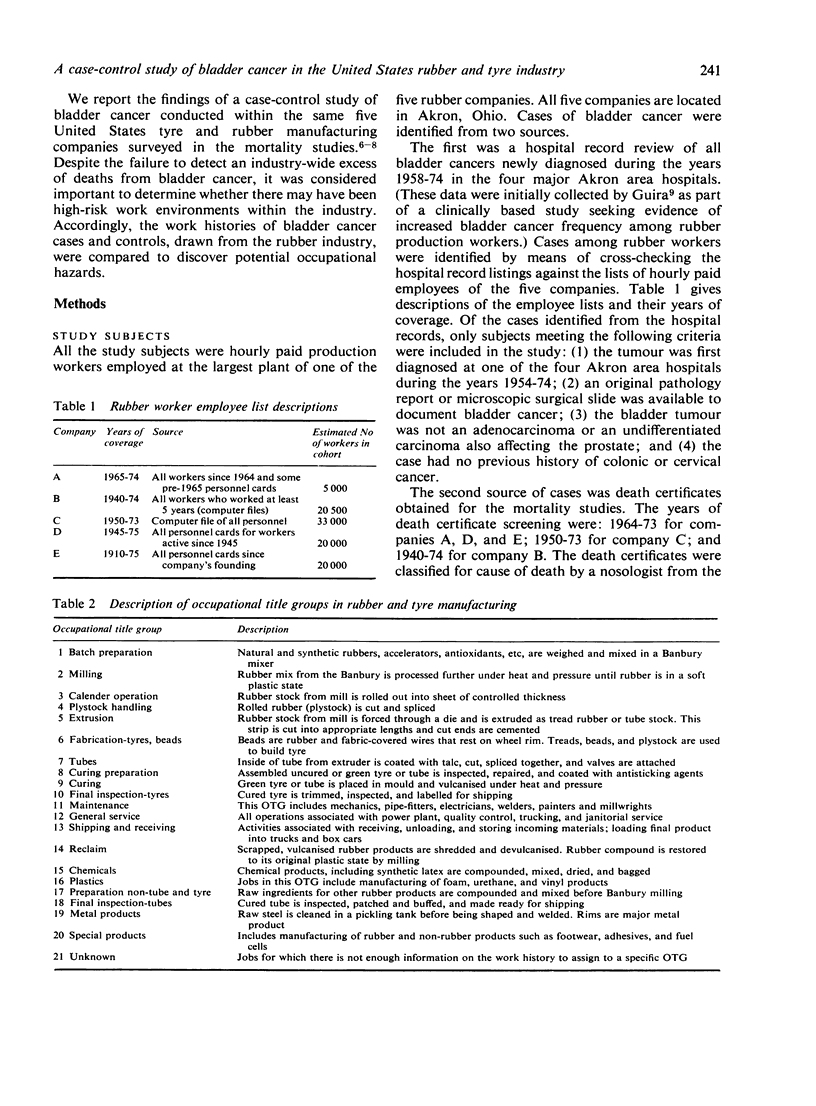
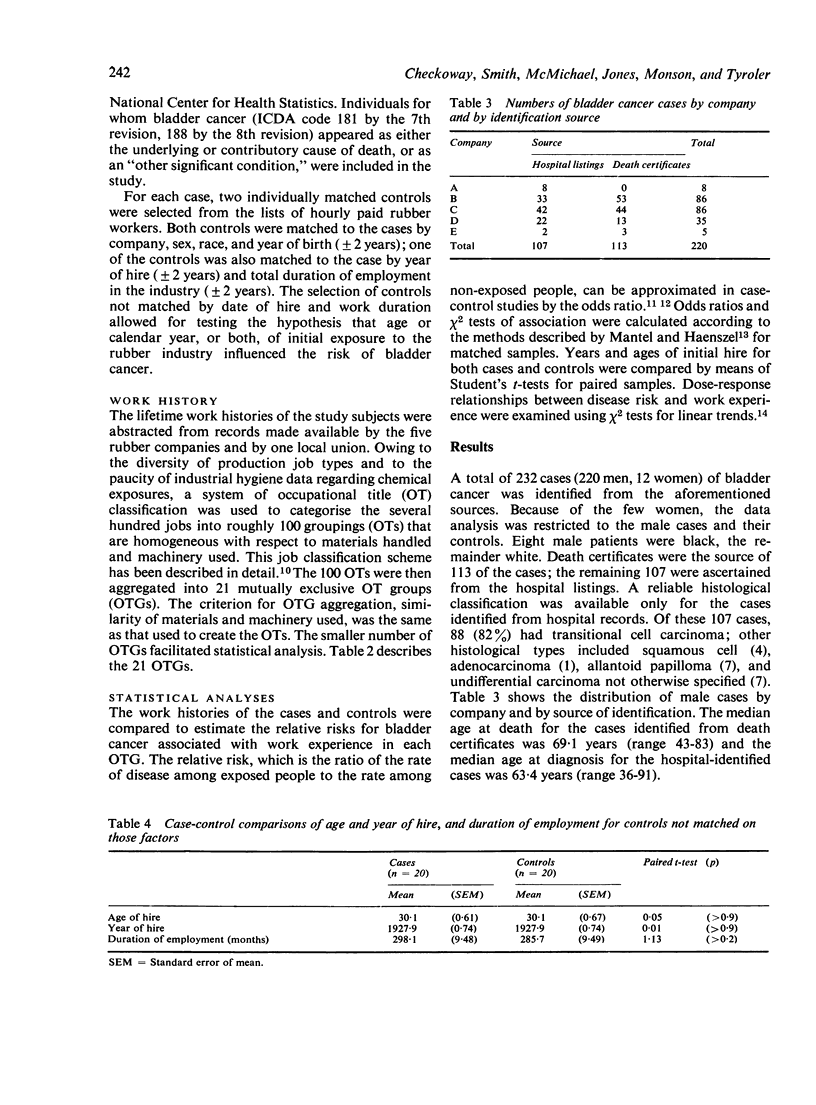
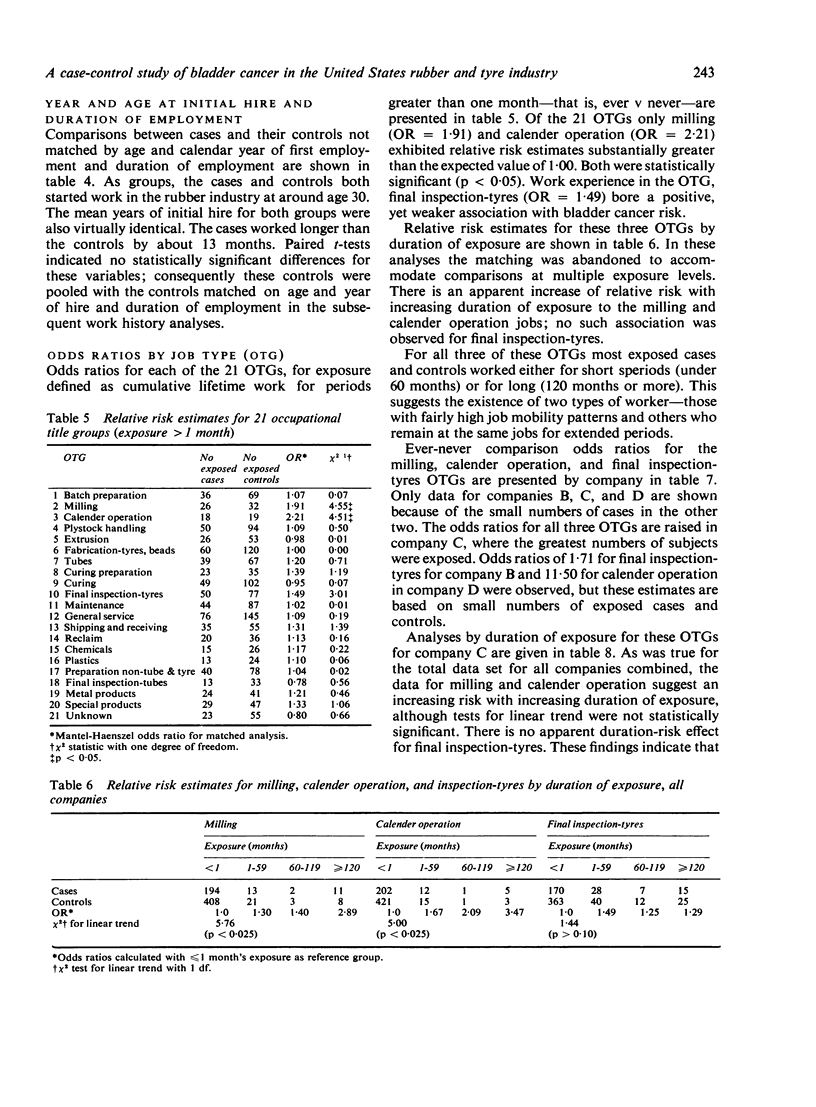
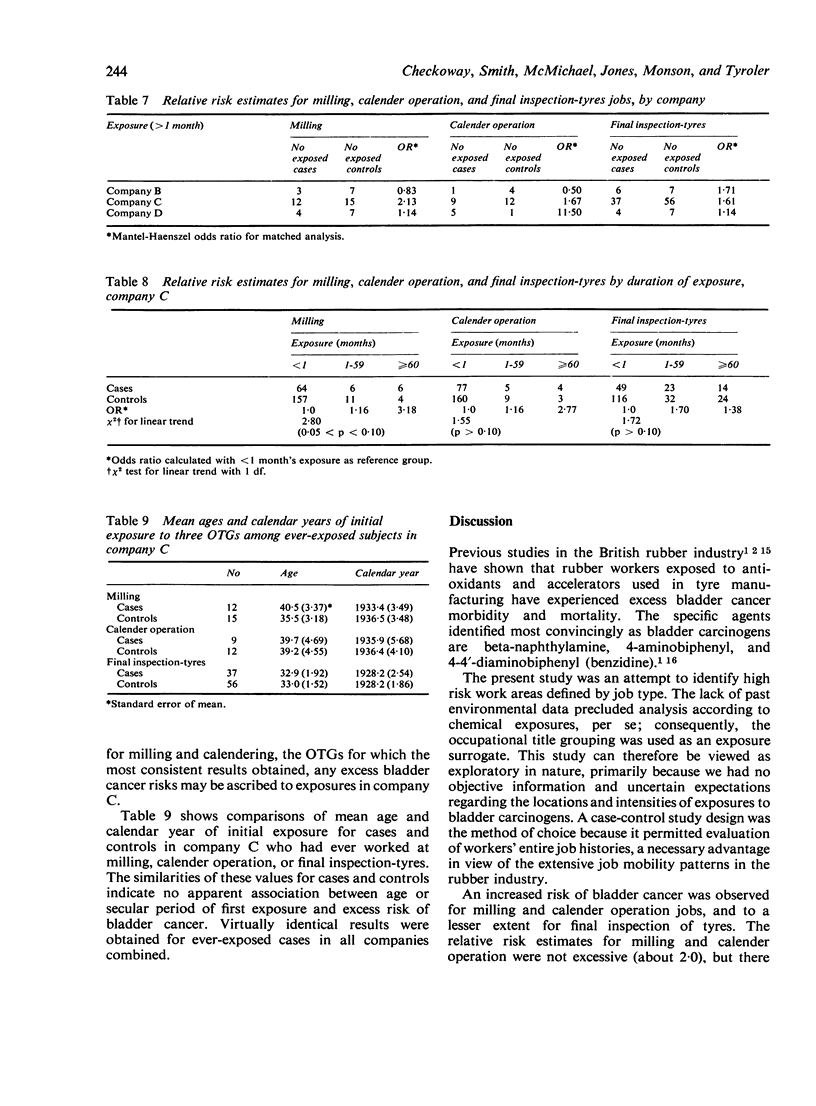
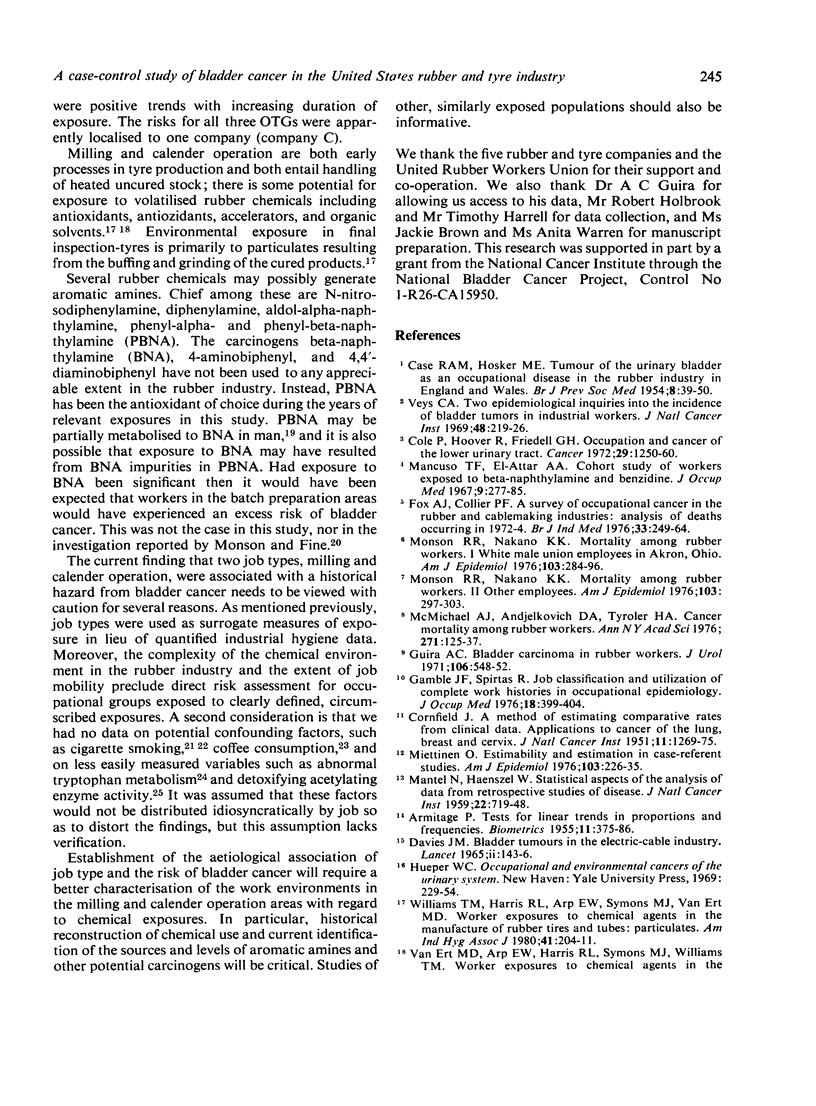

Selected References
These references are in PubMed. This may not be the complete list of references from this article.
- CASE R. A., HOSKER M. E. Tumour of the urinary bladder as an occupational disease in the rubber industry in England and Wales. Br J Prev Soc Med. 1954 Apr;8(2):39–50. doi: 10.1136/jech.8.2.39. [DOI] [PMC free article] [PubMed] [Google Scholar]
- CORNFIELD J. A method of estimating comparative rates from clinical data; applications to cancer of the lung, breast, and cervix. J Natl Cancer Inst. 1951 Jun;11(6):1269–1275. [PubMed] [Google Scholar]
- Cole P. Coffee-drinking and cancer of the lower urinary tract. Lancet. 1971 Jun 26;1(7713):1335–1337. doi: 10.1016/s0140-6736(71)91890-3. [DOI] [PubMed] [Google Scholar]
- Cole P., Hoover R., Friedell G. H. Occupation and cancer of the lower urinary tract. Cancer. 1972 May;29(5):1250–1260. doi: 10.1002/1097-0142(197205)29:5<1250::aid-cncr2820290518>3.0.co;2-t. [DOI] [PubMed] [Google Scholar]
- DAVIES J. M. BLADDER TUMOURS IN THE ELECTRIC-CABLE INDUSTRY. Lancet. 1965 Jul 24;2(7404):143–146. doi: 10.1016/s0140-6736(65)90228-x. [DOI] [PubMed] [Google Scholar]
- Fox A. J., Collier P. F. A survey of occupational cancer in the rubber and cablemaking industries: analysis of deaths occurring in 1972-74. Br J Ind Med. 1976 Nov;33(4):249–264. doi: 10.1136/oem.33.4.249. [DOI] [PMC free article] [PubMed] [Google Scholar]
- Guira A. C. Bladder carcinoma in rubber workers. J Urol. 1971 Oct;106(4):548–552. doi: 10.1016/s0022-5347(17)61338-7. [DOI] [PubMed] [Google Scholar]
- LEVIN M. L., LILIENFELD A. M., MOORE G. E. The association of smoking with cancer of the urinary bladder in humans. AMA Arch Intern Med. 1956 Aug;98(2):129–135. doi: 10.1001/archinte.1956.00250260001001. [DOI] [PubMed] [Google Scholar]
- MANTEL N., HAENSZEL W. Statistical aspects of the analysis of data from retrospective studies of disease. J Natl Cancer Inst. 1959 Apr;22(4):719–748. [PubMed] [Google Scholar]
- Mancuso T. F., el-Attar A. A. Cohort study of workers exposed to betanaphthylamine and benzidine. J Occup Med. 1967 Jun;9(6):277–285. [PubMed] [Google Scholar]
- McMichael A. J., Andjelkovic D. A., Tyroler H. A. Cancer mortality among rubber workers: an epidemiologic study. Ann N Y Acad Sci. 1976;271:125–137. doi: 10.1111/j.1749-6632.1976.tb23101.x. [DOI] [PubMed] [Google Scholar]
- Miettinen O. Estimability and estimation in case-referent studies. Am J Epidemiol. 1976 Feb;103(2):226–235. doi: 10.1093/oxfordjournals.aje.a112220. [DOI] [PubMed] [Google Scholar]
- Monson R. R., Nakano K. K. Mortality among rubber workers. I. White male union employees in Akron, Ohio. Am J Epidemiol. 1976 Mar;103(3):284–296. doi: 10.1093/oxfordjournals.aje.a112226. [DOI] [PubMed] [Google Scholar]
- Monson R. R., Nakano K. K. Mortality among rubber workers. II. Other employees. Am J Epidemiol. 1976 Mar;103(3):297–303. doi: 10.1093/oxfordjournals.aje.a112227. [DOI] [PubMed] [Google Scholar]
- Veys C. A. Two epidemiological inquiries into the incidence of bladder tumors in industrial workers. J Natl Cancer Inst. 1969 Jul;43(1):219–226. [PubMed] [Google Scholar]
- Williams T. M., Harris R. L., Arp E. W., Symons M. J., Van Ert M. D. Worker exposure to chemical agents in the manufacture of rubber tires and tubes: particulates. Am Ind Hyg Assoc J. 1980 Mar;41(3):204–211. doi: 10.1080/15298668091424618. [DOI] [PubMed] [Google Scholar]


